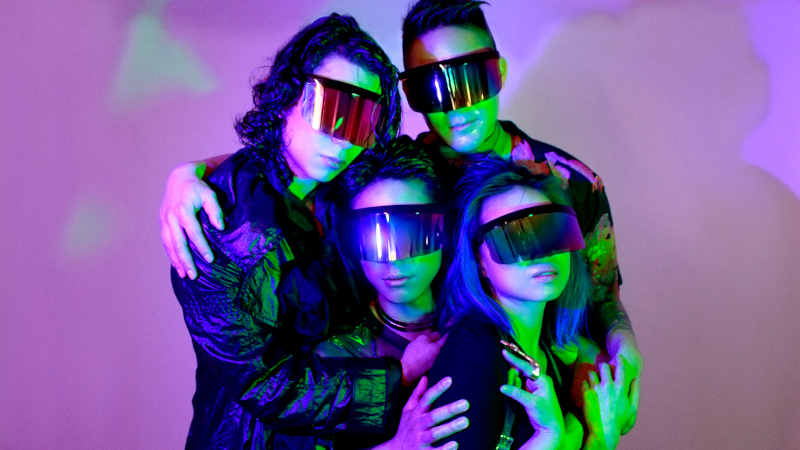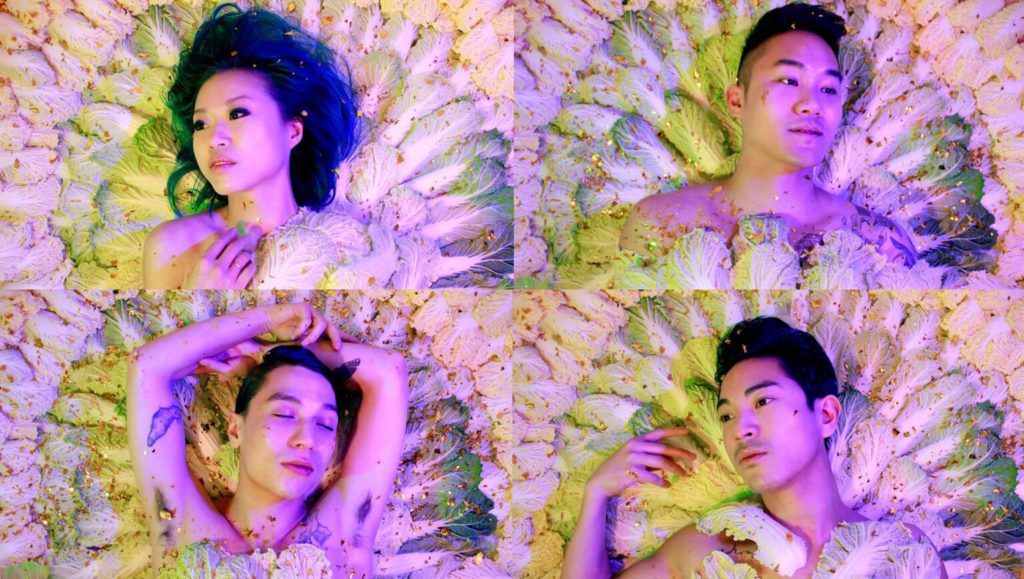West Coast Curated: Queer Chinese Diasporic Identity Narratives in Vancouver’s Chinatown

[In Vancouver’s historic Chinatown, across from markets piled high with dried goods and and a bakery that would be easy to pass by unnoticed (if it wasn’t for out-the-door line-ups) is the equally nondescript entrance to the Sun Wah Centre. The brick building is home to a cultural wealth of artists, and is currently housing Yellow Peril: Celestial Elements, a multi-media one-room immersive art show brought to life by Love Intersections, a media arts collective of queer Vancouver artists of colour.
Inside the centre and up a delightfully vintage looking elevator decorated with printed community notices in multiple languages, the fourth floor is home to the SUM Gallery. (Turn right from the elevator, walk straight through the kitchen, you’ll see the door.)
To stand in the small space with vibrant multi-channel video dominating half the room and pieces to explore, interpret and understand, is an experience to open yourself up to. The room brings together Chinese tradition, text, iconography and spirituality with West Coast North American settings, nature and mythos, that contemplate presences that are Indigenous, colonial and pop.
I connected with Jen Sungshine and David Ng, co-creative directors of Love Intersections to talk a bit more about the experience they created.
Is this the first time Love Intersections has curated an arts exhibit?
Jen: Yes! We started in 2014 as a media arts collective, making short documentaries of queer people of colour in our community. This is our first foray into visual arts and curation, and we are very grateful to the Pride in Arts Society/SUM gallery for their faith and generosity!
Your film, Yellow Peril: Queer Destiny debuted at the Vancouver Queer Film Festival in August 2019. A part of this exhibit breaks down some of the visuals from the film into multi-channel video projections. Would you consider this exhibit an extension of the film?

Jen: The exhibit was inspired by our 2019 experimental documentary, Yellow Peril: Queer Destiny, which follows local drag artist, Maiden China in a non-linear, 5-chapter narrative through the use of the Chinese Five Elements as a conduit for examining race, gender, sexuality, art and cultural “authenticity”.
David: Encouraged by the film’s success, we were given an opportunity to expand the film into a visual art exhibit to further explore what it means for us to be queer Asians of the diaspora. One of the main through-lines of both the film and the exhibit is bringing forth our ancestors/ancestry, into our re-imaginations of queer Asian futures. The four channel format allowed us to expand upon some of what we started with the 5 elements, and explore queerness, time, space, and identity in a different way.
The experience of being in the room, particularly on your own or perhaps in a small group, is very immersive. Can you tell me about the part the sound you chose plays into the exhibit?
David: The soundscape put together by Jamie Abugov is inspired by a mix of contemporary and traditional artists of Asian descent. We wanted to mix past and present music, to again play with the idea of time and space, queer identity, and cultural identity.

Tell us about “yellow peril”, turn-of-the-century racist terminology, and about the choice to use it in both the film and the exhibit.
David: Yes, the “Yellow Peril” was a racist narrative in the west in the early 1900s that framed the influx of Asian immigrants – mostly indentured labourers – as “invading” the West. Literature, film, and media representations would portray Asian people as conniving, drug using criminals, who had sinister agendas to infiltrate and invade the West. This anti-Asian racism is what drove the anti-Oriental riots, and the Asian exclusion acts in North America, and Europe.
Jen: We were drawn to the term “Yellow Peril” because we wanted to reclaim the term, and also turn it on it’s head. We’ve seen a sharp rise in queer Asian cultural organizing recently across Canada, and in a way our reclamation and insistence on enunciating our cultural identities, is “perilous” to white supremacy.
We also wanted to reference Paul Wong’s touring exhibition Yellow Peril: Reconsidered, as the exhibit (and Paul’s work) has been not only an inspiration for us, but paved the way for queer Asian artists today to express ourselves.
Part of this piece, according to the placards, has to do with dislodging Western linearity. Could you speak more about this?
Jen: In putting together the film and the exhibit, we started realizing that the notion of linear temporality – that is, time moving forward, sequentially – has limitations to our imaginations of queer cultural identity. The linear framework of “past-present-future”, for example, delimits our ability to think about how our ancestors dreamed us into the future; and that we are the product of our ancestors dreams.
David: We also wanted to push our ways of thinking about queer Asian identity, time, and space; outside of a Western point of departure. So we turned to the 5 elements in Chinese tradition, which are used in many facets of life, including medicine, spirituality, health, metaphysics, etc. In some ways, the 5 elements became the vehicle that we used to explore queer Asian cultural identity.

Please tell me about anything else you would like to add that you feel is integral to understanding this exhibit and your work.
Jen: We feel extremely lucky to have an outpour of support from the various communities we are a part of. Over 300 people showed up to our opening, holy moly! Beyond just coming to see the exhibit, we really want to create a sense of -space- within the confines of SUM Gallery. In working with, and exhibiting at, SUM, we recognize how meaningful it is to showcase in Chinatown’s BC Artscape Sun Wah building at 268 Keefer, home to over 70 artists, galleries, and culture work spaces dedicated to heritage, education, social justice and sustainability. There is a lot of conversation right now around “Vancouver’s changing Chinatown” and what that means for residents navigating an increasingly challenging, and changing, landscape.
David: We hope to express to visitors the importance of showcasing in such an environment and to ask ourselves, “why am I here? What kind of art, spaces and communities do I want to immerse and spend time in?” and for visitors to consider the meaningfulness of dedicated, artful spaces that we all play a role in curating. For us, it’s sharing and curating with the likes of fellow artists, Paul Wong and Sammy Chien, as well as with organizations we look up to, like Centre A, Full Circle: First Nations Performance, Youth Collaborative for Chinatown, Moniker Press, The Frank Theatre – we see ourselves as one small piece of the social puzzle, each of us weaving together a larger, multidimensional narrative of Chinatown. We hope that visitors will confront what it means to stand up for land rights/defenders, anti-racism, and thoughtful cultural spaces as we continue having wholehearted conversations together.
Jen: We have programmed several “activation” events throughout the exhibit run at SUM Gallery. Visitors should come to our Community Food Sharing + Dumpling Making activation on March 7, as well as the Grave Sweeping Activation / Closing Ceremony on April 4. All activation events are from 3:30pm-5:30pm.
From now until April 18th, 2020, Yellow Peril: Celestial Elements is on display at the SUM Gallery, with works by Jen Sungshine, David Ng, Kendell Yan/Maiden China and Jay Cabalu.
UPDATE: This show is now available for viewing by appointment only to encourage social distancing due to COVID-19. Contact info@queerartsfestival.com to arrange.
Written for West Coast Curated by Alexis Baran
